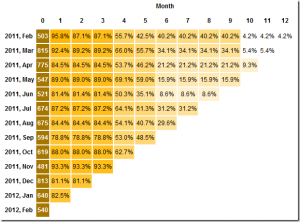Want some advice on how to market your startup or product? Well, here are my two cents based on a number good and bad launches. Basically you need a runway of 100 days to do all the preparations and create the buzz in good time. Usually you are on a tight or non existing budget so let me give you a plan where you pay in sweat instead.
100 days before the launch
Create your product pitch. Who is your ideal user of your product and what problem does it solve? How are you different from your competitors and how will you make money? Remember, be “Clear over Creative” when trying to explain what you do. Try it on a friend .
Also, figure out your credibility in the industry. Are you a serial entrepreneur or have other merits from your career? Do you have credible VC funding? Do you have or can piggyback on an important partnership with an organisation or individual?
90 days before the launch
Optimize your website. Make sure the copy and marketing messages are clear and compelling. Talk about the benefits for the user, not the features of your product. Add contact details and background story on why you are the best team to succeed in your area. Do the same for Facebook page, Twitter account etc.
80 days before the launch
Plan which 5 (at least) conferences or meetups you will attend before you launch. If you get to speak at one of them it is really awesom. Spread the word about your startup to fans, VC’s and journalists. Prominent people in your industry talk to each other. The more people that have heard about you by name, the more reason they have to talk about you. Also tech journalists often ask entrepreneurs and VC’s which companies are the hottest startups.
70 days before the launch
Build and launch a waiting list page for your product or startup; “Sign up with your email” Promote it to your network in all social channels. If people sign up it’s good validation that you are doing something good. Also, when people are talking about you they can recommend their friends to sign up for the waiting list.
63 days before the launch
Find 50 journalists or prominent bloggers that have written about your industry, competitors or potential partners. When they write about stuff that is relevant to you, make sure to contact them and thank them for a great article. It’s great way to connect without being intrusive. If you later find related content they would be interested in reading (not your site) attach the link and a few sentences around why this should be interesting. Also follow them on twitter or any other channels you can find.
56 days before the launch
Create send lists with 50-60 journalist emails, all of your friends AND 100 bloggers.
If you find it a drag digging up emails to bloggers and journalists, pay someone on Elance to do it for 50 dollars. It’s about 10-15 hours of work.
49 days before the launch
Learn about “how to spin a blog post”
and “how to get a 1000 likes on an infographic”.
42 days before the launch
Host a dinner with some good people to establish yourself in the ecosystem of your industry. It’s good to do as an extension when attending a conference. Book a table for 7-8 people at a good restaurant. Book a few good names prior to the conference. Invite the rest as you meet interesting people at the conference. Hosting a dinner is a great way to build relations that matter and make a name for you and your company. Pick up the bill!
35 days before the launch
Write an email to 20 prominent journalists (that you have been in contact with) that you think might be interested in writing about your launch. Be casual. “Hi we are launching InstaProductify in about a month from now. Would you like to do an interview or be interested in covering the story? We’ve had great response so far and this will be an awesome launch. If not, let’s just keep in touch.” No more than that. Attach a link to your site and/or invite site.
If they want to do interviews, make sure to do them as soon as possible. You will not have the time the final week.
28 days before the launch
Write your launch blog post and/or press release. If you have the time, write two and ask a friend which one they prefer.
Make sure you make it easy for the journalist that will want to write about you. Prepare to attach screenshots, logos, founders photos etc. in the emails you want to send. Don’t force them to visit your site and download a 50 MB presskit with high-res photos. Make it easy to write about you.
21 days before the launch
Write the email that you will send to the people on your invite list. Write the email that you will send to friends and contacts in your network. Be sure to end the email with a call to action like: “the launch blog post will be at this link. Be sure to tweet about it on launch day!”
Write all social media posts that you want to push. Preferably three stages of the launch “Something is coming”, “Tomorrow is the big day” and “Today we launch! Boom!”
14 days before the launch
Guest blog. Find a blog that is a prominent blog in your industry or just has a lot of readers. Share your thoughts and experiences from building a product/startup or reveal some incredible insight that will disrupt your industry. Top 10 lists works amazingly well.
7 days before the launch
Email the journalists that you have been in contact with and give them the full story. Make
it easy for them to write about you as discussed in 28 days before the launch. Make sure to book any remaining interviews if you can. Also make sure you understand the journalists angle. Tech journalists probably asks you different questions compared to a reporter for a paper in your industry.
4 days before the launch
Create any ads that you might have prepared for Facebook of similar channels.
3 days before the launch
Email all the journalists on your list that you haven’t contacted yet, ONE BY ONE. Include their name in the greeting. Announce the launch, the elevator pitch about your product/startup and launch day. Include that the announcement is embargoed until the launch day. If they are serious journalists, they will respect that.
2 days before the launch
Email all the bloggers in bulk, or if you have the time, one by one. Do the same for your contacts/friends list. When you do bulk, remeber to put everybody in the BCC field, not the TO field. Showing your send list in public is unprofessional. I have done this when I was tired once and I got some angry emails back. Very embarrassing.
1 day before the launch
If you have done everything right, I don’t have to tell you what to do on this day. You will have tons of email to answer, launch copy to finalize and champagne to buy. If you can, go for a run or long walk to get the adrenaline out of your body and have a good nights sleep.
Launch day
Toast and smile.
14 days AFTER the launch
Blog and share the story about your launch. It’s a great way to extend the buzz of your launch with one more wave, to catch people who missed your launch or people (VC’s) that want to see you get traction.
God speed!
















 I work at Osom. I used to say “I’m starting a company”, but these days I’m not starting, I’m working. So what’s the difference?
I work at Osom. I used to say “I’m starting a company”, but these days I’m not starting, I’m working. So what’s the difference?


